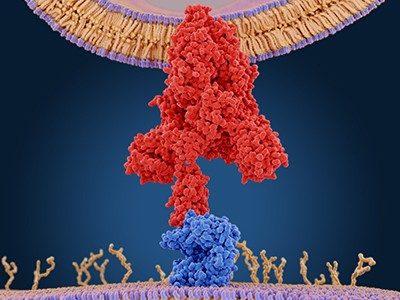FOR IMMEDIATE RELEASE | April 13, 2022
Coronaviruses evolve to recognize glycans of their host species
“Synthetic O-Acetyl-N-glycolylneuraminic Acid Oligosaccharides Reveal Host-Associated Binding Patterns of Coronaviral Glycoproteins”
ACS Infectious Diseases
When coronaviruses jump species — as SARS-CoV-2 is thought to have done from bats or pangolins to humans — they must quickly adapt to their new host. For example, they must evolve to recognize the unique sugar molecules, or glycans, that decorate proteins on the host cell’s surface. Now, researchers reporting in ACS Infectious Diseases have characterized the binding of proteins from several animal and human coronaviruses to glycans called sialic acids, revealing host-specific patterns of binding.
Sialic acids are negatively charged, nine-carbon sugar molecules that cap the ends of sugar chains attached to proteins on the cell’s surface. In vertebrates, N-acetylneuraminic acid (Neu5Ac) and N-glycolylneuraminic acid (Neu5Gc) are the most common forms of sialic acids. Enzymes can add acetyl groups to various places on these molecules, making more than 10 molecular variants of each. Geert-Jan Boons and colleagues wanted to characterize the repertoire of sialic acid variants recognized by two viral proteins, the receptor binding domain (RBD) of the spike protein and hemagglutinin-esterase (HE), from several animal and human coronaviruses.
The researchers used chemical and enzymatic treatments to prepare a complete library of acetylated Neu5Ac and Neu5Gc variants. They printed these molecules onto a glass slide to produce a microarray. Next, the team used a fluorescent antibody detection system to determine whether the RBD and HE from bovine, rabbit, equine and canine coronaviruses bound to specific spots on the microarray. Because human coronavirus HEs have lost the ability to bind sialic acid-containing carbohydrates, they tested only the RBD from the human coronavirus OC43, which typically causes mild cold-like symptoms. The researchers found that HE from each species bound less to Neu5Gc than Neu5Ac variants. The RBDs from each species bound to both Neu5Ac and Neu5Gc variants, but with different patterns. The results revealed that coronaviruses have fine-tuned their specificities to adapt to the sialic acid variants of their host. This information could provide important insights into the factors driving cross-species transmission, helping scientists to predict and prevent future outbreaks, the researchers say.
The authors acknowledge funding and support from the Netherlands Organization for Scientific Research, the Human Frontier Science Program Organization, the Council for Chemical Sciences of the Netherlands Organization for Scientific Research and the China Scholarship Council.
To automatically receive press releases from the American Chemical Society, contact newsroom@acs.org.
Note: ACS does not conduct research, but publishes and publicizes peer-reviewed scientific studies.
Media Contact
ACS Newsroom
newsroom@acs.org


